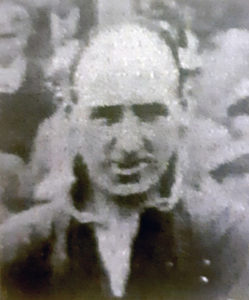…Rovers began the 1931/32 season wearing their now famous blue and white quartered shirts for the first time and John was in the side for the first game of the new season, which ended in a 2-2 draw against Bournemouth at Dean Court.
The third game of that campaign, on September 5th, saw Rovers record a 6-1 home win against Crystal Palace and Muir was credited with two of those goals, with Ronnie Dix and Arthur Attwood also scoring two apiece. An Eastville crowd of 9,000 saw that game.
Here’s how the scoring went, through the eyes of one intrepid local reporter; ‘The first goal came after half an hour’s play and it was obtained by Dix with a great low effort following an opening made by Oakton who, at outside right, was very happy all through the piece.
‘Eight minutes from the interval the Rovers’ advantage was increased by Attwood with a clever cross and although the Rovers’ supporters were happy in this happening they were made even happier just before the change of ends for then Muir scored for the Rovers from fairly long range while Callender, the Palace goalkeeper, was dividing his attention between the play and one of his colleagues who was injured on the ground only a few yards from goal.
‘If Crystal Palace had hopes of early and easily wiping off the arrears against them, they were destined to be disappointed for the Rovers resumed just where they left off. That is to say they were as aggressive at the start of the second half as they were at the end of the first.
‘The second half was only ten minutes old when Muir scored a lovely second goal through a forest of legs following a corner well placed by Oakton.
‘For a moment or two the visitors were given breathing space and they used it by Carke beating Calvert for the first time in the match.
‘This was replied to by Dix and Rovers completed their half dozen through Attwood who headed the ball into the net.’
Rovers: Calvert, Pickering, Russell, Routledge, Stoddart, Muir, Oakton, Dix, Attwood, Townrow, Young.
Four days later Muir was in the side beaten 1-0 by Bristol City in the Gloucestershire Cup Final in front of 11,000 fans at Eastville.
Having started the first ten games of the season, John didn’t appear in the side again until a 2-2 draw against Cardiff City on November 21st. that was his last first team appearance until February 1932 when he played in consecutive games, against Norwich City and Swindon Town. Both games were lost and the Swindon game, on February 20th, proved to be his last for Rovers.
Swindon were 2-0 winners at Eastville in what turned out to be his final league game for the club and this is what the press made of it; ‘Bristol Rovers had a bad day on Saturday at Eastville where Swindon Town, with ten men (Morris was injured during the game), beat them by two clear goals before just over 5,000 spectators.
‘Facing such lively cohesive opponents, the Rovers forwards seemed very ragged in combination. Dix could not get the measure of Godfrey while Muir, his partner, could scarcely get in a single uninterrupted pass and in the second half played half back while Townrow went forward.’
Rovers: Calvert, Smith, Townrow, Black, Pickering, Muir, Oakton, Cook, Riley, Dix, Cooper.
The side finished in 18th position at the end of the 1931/32 campaign and in August 1932 he returned, briefly, to another of his former clubs, Bo’ness and he played in their final league game before their expulsion from the league for financial irregularities.
November 1932 saw him join Arbroath and score four goals in 74 league games and that preceded a move to East Stirling in August 1935 where, in his one season with them, he appeared in 34 league games.
On hanging up his boots he worked as a soft goods manufacturer and died from a heart attack on April 29th, 1959, the day of his grand daughter’s birthday.
A rather grainy image taken after he had left Rovers and was playing in Scotland.
Keith Brookman



